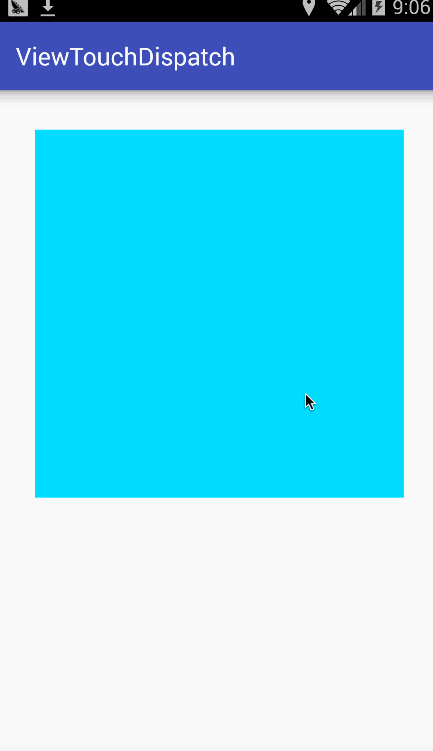概述
之前在学习android事件方法机制的时候,看过不少文章,但是大部分都讲的不是很清楚,我自己理解的也是云里雾里,也尝试过阅读源码,看得我更是不知所措。最近阅读了《Android开发艺术探索》一书中相关的章节,茅塞顿开,写下本文作为阅读笔记,以便以后查阅。
三个重要的方法
public boolean dispatchTouchEvent(MotionEvent ev)事件传递过来的时候这个方法第一个被调用,返回结果受当前View的ontouchEvent()方法或者下一级View的dispatchTouchEvent()方法返回值影响。
public boolean onInterceptTouchEvent(MotionEvent ev)这个方法是在dispatchTouchEvent()方法内部掉用的,返回值用来判断是否拦截当前事件。
public boolean onTouchEvent(MotionEvent ev)也是在dispatchTouchEvent()方法中掉用,用来处理某一事件。
事件的传递规则
书中用了一段伪代码来表示
public boolean dispatchTouchEvent(MotionEvent ev) {
boolean consume = false;
if (onInterceptTouchEvent(ev)) {
consume = onTouchEvent(ev);
} else {
consume = child.dispatchTouchEvent(ev);
}
return consume;
}也就是说当一个事件到来的时候,当前View的dispatchTouchEvent方法会被调用,在内部首先调用onInterceptTouchEvent判断是否拦截,如果拦截,将事件传递给自己的onTouchEvent对事件进行处理。如果不拦截,就将事件传递给子View,调用子View的dispatchTouchEvent方法,一直到事件被消费。
源码分析
上面的内容讲的很抽象,不好理解,接下来配合源码来讲解,这样更加的容易深入理解事件分发机制。
判断是否拦截
事件到来的时候,View的第一个工作自然是判断是否拦截,下面给出dispatchTouchEvent中拦截的相关代码
// Check for interception.
final boolean intercepted;
if (actionMasked == MotionEvent.ACTION_DOWN
|| mFirstTouchTarget != null) {
final boolean disallowIntercept = (mGroupFlags & FLAG_DISALLOW_INTERCEPT) != 0;
if (!disallowIntercept) {
intercepted = onInterceptTouchEvent(ev);
ev.setAction(action); // restore action in case it was changed
} else {
intercepted = false;
}
} else {
// There are no touch targets and this action is not an initial down
// so this view group continues to intercept touches.
intercepted = true;
}这里要注意的是,事件分发机制针对的其实可以看作是一系列的事件,也就是一个事件序列,也就是说一个事件序列由一个DOWN开头,中间n个MOVE,然后以UP或者CANCEL结束。
代码中mFirstTouchTarget在子元素成功处理事件的时候会进行赋值,也就是说当事件不是DOWN,而且没有子元素成功处理的时候,直接拦截事件自己处理。这很好理解,如果不是DOWN说明事件序列已经开始传递了,那么如果子元素不处理最开始的DOWN说明它不想要这个序列,那么就自己处理,一直到新的事件序列到来(也就是新的DOWN)。也就是说一旦我们处理一个事件就不会多次调用onInterceptTouchEvent方法。
另一种情况是DOWN到来,也就是新的事件序列开始,或者子View成功处理过这个序列,就会进行判断。判断第一步是判断FLAG_DISALLOW_INTERCEPT标志位,这个标志位是通过requestDisallowInterceptTouchEvent方法设置的,一般是子View调用的,如果不允许拦截,就不拦截。如果允许,那就调用自己的onInterceptTouchEvent方法来判断。
值得注意的是当DOWN事件到来的时候,会重置标志位,且清除mFirstTouchTarget,就是新序列到来的时候一切重置。
// Handle an initial down.
if (actionMasked == MotionEvent.ACTION_DOWN) {
// Throw away all previous state when starting a new touch gesture.
// The framework may have dropped the up or cancel event for the previous gesture
// due to an app switch, ANR, or some other state change.
cancelAndClearTouchTargets(ev);
resetTouchState();
}不拦截事件
如果最后不拦截事件,那么就应该分发下去
{
final int childIndex = customOrder
? getChildDrawingOrder(childrenCount, i) : i;
final View child = (preorderedList == null)
? children[childIndex] : preorderedList.get(childIndex);
// If there is a view that has accessibility focus we want it
// to get the event first and if not handled we will perform a
// normal dispatch. We may do a double iteration but this is
// safer given the timeframe.
if (childWithAccessibilityFocus != null) {
if (childWithAccessibilityFocus != child) {
continue;
}
childWithAccessibilityFocus = null;
i = childrenCount - 1;
}
if (!canViewReceivePointerEvents(child)
|| !isTransformedTouchPointInView(x, y, child, null)) {
ev.setTargetAccessibilityFocus(false);
continue;
}
newTouchTarget = getTouchTarget(child);
if (newTouchTarget != null) {
// Child is already receiving touch within its bounds.
// Give it the new pointer in addition to the ones it is handling.
newTouchTarget.pointerIdBits |= idBitsToAssign;
break;
}
resetCancelNextUpFlag(child);
if (dispatchTransformedTouchEvent(ev, false, child, idBitsToAssign)) {
// Child wants to receive touch within its bounds.
mLastTouchDownTime = ev.getDownTime();
if (preorderedList != null) {
// childIndex points into presorted list, find original index
for (int j = 0; j < childrenCount; j++) {
if (children[childIndex] == mChildren[j]) {
mLastTouchDownIndex = j;
break;
}
}
} else {
mLastTouchDownIndex = childIndex;
}
mLastTouchDownX = ev.getX();
mLastTouchDownY = ev.getY();
newTouchTarget = addTouchTarget(child, idBitsToAssign);
alreadyDispatchedToNewTouchTarget = true;
break;
}
// The accessibility focus didn't handle the event, so clear
// the flag and do a normal dispatch to all children.
ev.setTargetAccessibilityFocus(false);
}就是遍历子View,通过是否在播放动画和事件是否落在它的范围内来获得合适的View,如果存在就调用它的dispatchTouchEvent方法。
我们需要获得dispatchTouchEvent返回的值来判断子View是否成功消耗了事件,如果返回的是true代表成功消费,那么就会对mFirstTouchTarget进行赋值
newTouchTarget = addTouchTarget(child, idBitsToAssign);
alreadyDispatchedToNewTouchTarget = true;
break;这个赋值很重要,如果不消耗那么就不会赋值,也就是说mFirstTouchTarget== null,那么接下来的事件(同一序列,也就不会再产生DOWN了)都有本View消耗,不再分发。
当然,如果最后发现没有合适的子View或者子View返回了false,那么都由本View处理,也就是onTouchEvent,这也就是为什么事件到了最底层还没被消耗(返回true)就会重新向上传递到上一层的onTouchEvent处理的原因了。
拦截事件
那就开始自己处理事件,接下来的内容就会详细讲解。
View对事件的处理
ListenerInfo li = mListenerInfo;
if (li != null && li.mOnTouchListener != null
&& (mViewFlags & ENABLED_MASK) == ENABLED
&& li.mOnTouchListener.onTouch(this, event)) {
result = true;
}
if (!result && onTouchEvent(event)) {
result = true;
}这里的View不包含ViewGroup,可以看到当要处理事件的时候首先判断是否设置了OnTouchListener,如果设置了就调用onTouch方法。如果onTouch返回了true,那么就直接返回,不会去调用ontouchEvent。如果返回了false,就回调用ontouchEvent,返回onTouchEvent的返回值。
在onTouchEvent内部,如果设置了OnClickListener就会调用onClick方法。
总的来说,就是onTouchListener级别高于onTouchEvent,onClickListener最低。
案例解析
针对上述的理论分析,我们通过以下的Demo来结合实践加深理解。
首先自定义一个MyViewGroup和MyView,代码如下
public class MyView extends View {
public MyView(Context context) {
super(context);
}
public MyView(Context context, AttributeSet attrs) {
super(context, attrs);
}
}
public class MyViewGroup extends ViewGroup {
private MyView mChildView;
public MyViewGroup(Context context) {
this(context, null);
}
public MyViewGroup(Context context, AttributeSet attrs) {
super(context, attrs);
}
@Override
protected void onMeasure(int widthMeasureSpec, int heightMeasureSpec) {
super.onMeasure(widthMeasureSpec, heightMeasureSpec);
measureChildren(widthMeasureSpec, heightMeasureSpec);
}
@Override
protected void onLayout(boolean changed, int l, int t, int r, int b) {
if (changed) {
mChildView = (MyView) getChildAt(0);
mChildView.layout(l, t, l + mChildView.getMeasuredWidth(), t + mChildView.getMeasuredHeight());
}
}
}
很简单的自定义View和ViewGroup,我们接下来在布局文件中加入就可以了
<RelativeLayout xmlns:android="http://schemas.android.com/apk/res/android"
xmlns:tools="http://schemas.android.com/tools" android:layout_width="match_parent"
android:layout_height="match_parent" android:paddingLeft="@dimen/activity_horizontal_margin"
android:paddingRight="@dimen/activity_horizontal_margin"
android:paddingTop="@dimen/activity_vertical_margin"
android:paddingBottom="@dimen/activity_vertical_margin" tools:context=".MainActivity">
<com.wulingpeng.viewtouchdispatch.MyViewGroup
android:layout_width="match_parent"
android:layout_height="match_parent" >
<com.wulingpeng.viewtouchdispatch.MyView
android:layout_width="300dp"
android:layout_height="300dp"
android:background="@android:color/holo_blue_bright"/>
</com.wulingpeng.viewtouchdispatch.MyViewGroup>
</RelativeLayout>现在我们重写MyViewGroup和View的相关方法并打印结果
MyView.java
@Override
public boolean dispatchTouchEvent(MotionEvent ev) {
boolean dispatch = super.dispatchTouchEvent(ev);
Log.d("Debug", "MyView:dispatchTouchEvent " + dispatch);
return dispatch;
}
@Override
public boolean onTouchEvent(MotionEvent event) {
boolean onTouchEvent = super.onTouchEvent(event);
Log.d("Debug", "MyView:OnTouchEvent " + onTouchEvent);
return onTouchEvent;
}MyViewGroup.java
@Override
public boolean dispatchTouchEvent(MotionEvent ev) {
boolean dispatch = super.dispatchTouchEvent(ev);
Log.d("Debug", "MyViewGroup:dispatchTouchEvent " + dispatch);
return dispatch;
}
@Override
public boolean onInterceptTouchEvent(MotionEvent event) {
boolean isIntercept = false;
switch (event.getAction()) {
case MotionEvent.ACTION_DOWN:
isIntercept = true;
}
Log.d("Debug", "MyViewGroup:onInterceptTouchEvent " + isIntercept);
return isIntercept;
}
@Override
public boolean onTouchEvent(MotionEvent event) {
boolean onTouchEvent = super.onTouchEvent(event);
Log.d("Debug", "MyViewGroup:OnTouchEvent " + onTouchEvent);
return onTouchEvent;
}这里我们拦截了DOWN事件,接下来点击MyView的区域然后滑动,最后抬起。

打印结果如下
07-23 08:57:18.067 2831-2831/? D/Debug: MyViewGroup:onInterceptTouchEvent true
07-23 08:57:18.067 2831-2831/? D/Debug: MyViewGroup:OnTouchEvent false
07-23 08:57:18.067 2831-2831/? D/Debug: MyViewGroup:dispatchTouchEvent false明明滑动了一段距离,理论上有很多个MOVE事件,为什么只有三个打印呢?其实之前就已经说明了,我们拦截了DOWN事件,那么子元素是收不到DOWN事件的,结果就是该序列接下来的事件都是我们自己消费,且不会再次掉用onInterceptTouchEvent,由自己的onTouchEvent处理。因为我们的onTouchEvent返回了false,直接导致我们的dispatchTouchEvent也返回了false。那么MyViewGroup的上一层就不会把接下来的事件传递给我们了(上一层的mFirstTouchTarget没有赋值),所以接下来的事件都不会到来。
我们再改变一下,让MyViewGroup的onTouchEvent方法返回true,进行相同的操作,打印结果如下
07-23 09:08:48.727 3018-3018/? D/Debug: MyViewGroup:onInterceptTouchEvent true
07-23 09:08:48.727 3018-3018/? D/Debug: MyViewGroup:OnTouchEvent true
07-23 09:08:48.727 3018-3018/? D/Debug: MyViewGroup:dispatchTouchEvent true
......省略的打印信息就是第二条和第三条的多次重复,也就是说在接下来的MOVE到来的时候,由于之前拦截了DOWN,所以事件自己处理,不会再掉用onIntereptTouchEvent。
注意事项
- 一般在处理滑动冲突的时候重写相关方法,对于DOWN事件是不会拦截的,也就是返回false,在接下来的MOVE序列中判断是否需要拦截。因为如果拦截了DOWN,那么接下来的事件都不会传给子View了,之前已经分析过了。
- 一般也不会拦截UP事件,因为UP一般为序列的最后一个事件,拦截不拦截对自己没有什么用处,但是子View就可能因为收不到UP而无法触发click事件。






















 1160
1160

 被折叠的 条评论
为什么被折叠?
被折叠的 条评论
为什么被折叠?








